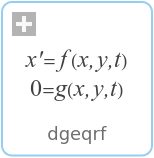WOLFRAM SYSTEM MODELER
dgeqrfCompute a QR factorization without pivoting |
|
Wolfram Language
In[1]:=

SystemModel["Modelica.Math.Matrices.LAPACK.dgeqrf"]
Out[1]:=

Information
This information is part of the Modelica Standard Library maintained by the Modelica Association.
Lapack documentation
Purpose
=======
DGEQRF computes a QR factorization of a real M-by-N matrix A:
A = Q * R.
Arguments
=========
M (input) INTEGER
The number of rows of the matrix A. M >= 0.
N (input) INTEGER
The number of columns of the matrix A. N >= 0.
A (input/output) DOUBLE PRECISION array, dimension (LDA,N)
On entry, the M-by-N matrix A.
On exit, the elements on and above the diagonal of the array
contain the min(M,N)-by-N upper trapezoidal matrix R (R is
upper triangular if m >= n); the elements below the diagonal,
with the array TAU, represent the orthogonal matrix Q as a
product of min(m,n) elementary reflectors (see Further
Details).
LDA (input) INTEGER
The leading dimension of the array A. LDA >= max(1,M).
TAU (output) DOUBLE PRECISION array, dimension (min(M,N))
The scalar factors of the elementary reflectors (see Further
Details).
WORK (workspace/output) DOUBLE PRECISION array, dimension (MAX(1,LWORK))
On exit, if INFO = 0, WORK(1) returns the optimal LWORK.
LWORK (input) INTEGER
The dimension of the array WORK. LWORK >= max(1,N).
For optimum performance LWORK >= N*NB, where NB is
the optimal blocksize.
If LWORK = -1, then a workspace query is assumed; the routine
only calculates the optimal size of the WORK array, returns
this value as the first entry of the WORK array, and no error
message related to LWORK is issued by XERBLA.
INFO (output) INTEGER
= 0: successful exit
< 0: if INFO = -i, the i-th argument had an illegal value
Further Details
===============
The matrix Q is represented as a product of elementary reflectors
Q = H(1) H(2) . . . H(k), where k = min(m,n).
Each H(i) has the form
H(i) = I - tau * v * v'
where tau is a real scalar, and v is a real vector with
v(1:i-1) = 0 and v(i) = 1; v(i+1:m) is stored on exit in A(i+1:m,i),
and tau in TAU(i).
Syntax
(Aout, tau, info, work) = dgeqrf(A)
Inputs (1)
| A |
Type: Real[:,:] Description: Square or rectangular matrix |
|---|
Outputs (4)
| Aout |
Default Value: A Type: Real[size(A, 1),size(A, 2)] Description: The upper triangle of the array contains the upper trapezoidal matrix R; the elements below the diagonal, together with the array TAU, represent the orthogonal matrix Q as a product of elementary reflectors |
|---|---|
| tau |
Type: Real[min(size(A, 1), size(A, 2))] Description: Scalar factors of the elementary reflectors |
| info |
Type: Integer |
| work |
Type: Real[3 * max(1, size(A, 2))] |
